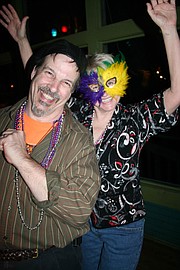Shortly before his graduation from Russellville High School in 1965, Richard Heidbreder recalls the Air Force recruiter visiting the school, full of promises of service that sounded much more palatable than those offered by the other military branches.
"Back in those days, we all kind of knew we were going to have to leave and go serve," said Heidbreder, 68, of Lohman, when describing the Vietnam era draft.
"When I talked to the recruiter, he told me that in the Air Force, I wouldn't be involved in hand-to-hand combat, and the food and facilities would be much better than the Marines and the Army," he grinned.
Enlisting in August 1965, the recruit traveled to Lackland Air Force Base (AFB) in San Antonio, Texas, spending the next several weeks in basic training. He was then assigned to Lowry AFB in Denver, Colorado, where he trained as a munitions handler.
"During the training," Heidbreder explained, "we learned to identify all of the munitions used by the Air Force including bombs and flares. Anything explosive," he added, "we would basically store and handle."
The airman then received orders for his first duty assignment at Richards-Gebaur AFB, south of Kansas City - a small base used to train fighter and transport pilots. While there, Heidbreder said, his duties included "handling of inert missiles that were used in training by the pilots."
After only a few months in his initial assignment, Heidbreder was transferred to Clark Air Base located on Luzon Island in the Philippines in June 1966.
"Once again, we were storing and transporting munitions used in training but we also handled some live stuff that was used during air patrols while we were there," he said, including the 2.75-inch rockets on which they would test the fuses and then "attach to the wings of the planes."
The following year, Heidbreder received a three-month assignment to Uda Pao, Thailand, to help establish a new air base from which the United States could launch bombing campaigns against targets in Vietnam - missions previously flown from the island of Guam.
"The base was basically built on a swamp and they had to haul in several feet of rock to fill it all in," he said. "While we were there, they poured pads and built revetments to store the munitions ... and then they began shipping in bombs to be used in Vietnam."
When his three-month tour ended, Heidbreder returned to Clark Air Base until November 1967, at which time he was transferred to McConnell AFB in Wichita, Kansas. He remained in his stateside duty location until receiving orders for Vietnam, returning overseas in July 1968.
Assigned to the 303rd Munitions Maintenance Squadron on Bien Hoa Air Base near the city of Saigon, Heidbreder says much like his earlier duty in Thailand, he was working with "the hard and heavy stuff," like the 750-pound bomb, which he described as the "bread and butter" of the bombing missions.
"Mainly I got into breaking down the pallets, loading the bombs (and components) on a truck, and taking them to the flight line were they were installed on the planes for the big drop," he said.
While stationed in Vietnam, he discovered much of what he had been told by his recruiter three years earlier resonated with a level of truth regarding their living conditions and work environment, and providing him with a renewed appreciation for his decision to join the Air Force.
"You'd see the Army guys coming onto base without having had a shower for days, who had been eating C-Rations and involved in heavy combat ... those guys really had a struggle," he said.
"The base was pretty secure except for the occasional rockets the NVA (North Vietnamese Army) would lob in. When that happened, they'd sound the alarm and you would head for the bunker."
On one occasion, the veteran recalled, an enemy rocket struck a revetment filled with bombs stored for upcoming missions, setting off an explosion that shook the base and left a crater in the ground nearly 100 feet deep.
"Somehow, I don't think anyone was killed on that one," he said.
In April 1969, Heidbreder was sent home and discharged from the military.
Shortly after returning to Lohman, he purchased a set of concrete forms and started Heidbreder Foundation Service, estimating his company has since poured more than 4,000 foundations.
He married his fiancée, Rosemary, on June 12, 1976, and the couple raised one son, Ryan, who now serves as Heidbreder's partner in the foundation business.
Though stories abound of many veterans coming home from the Vietnam War only to be greeted with disdain, Heidbreder affirms he received nothing but support from his Mid-Missouri community and was even able to extract a valuable lesson from his time in the service - primarily a quicker transition into adulthood.
"Looking back now, at that time (when we enlisted), you were young and inexperienced enough that you didn't really know what you were going to do with your life ... or what life was going to give you," Heidbreder remarked.
"But going off to the military was just something you took in stride; it was part of your duty to serve and became tremendous maturing period for me and a lot of other guys."
Jeremy P. Ämick writes on behalf of the Silver Star Families of America.

